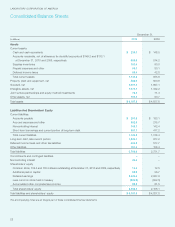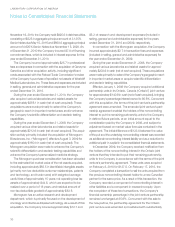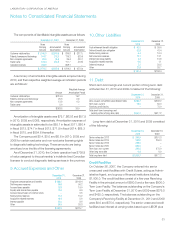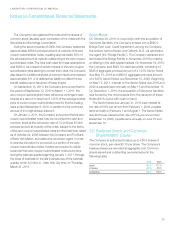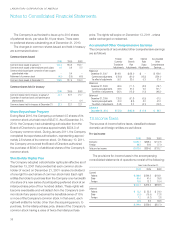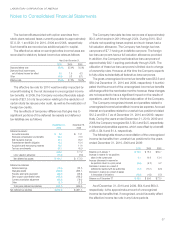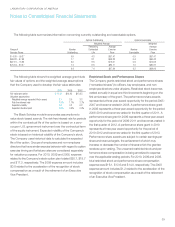LabCorp 2010 Annual Report Download - page 31
Download and view the complete annual report
Please find page 31 of the 2010 LabCorp annual report below. You can navigate through the pages in the report by either clicking on the pages listed below, or by using the keyword search tool below to find specific information within the annual report.29
LABORATORY CORPORATION OF AMERICA
Notes to Consolidated Financial Statements
change in tax rates is recognized in income in the period that
includes the enactment date. The Company does not recognize
a tax benefit, unless the Company concludes that it is more
likely than not that the benefit will be sustained on audit by the
taxing authority based solely on the technical merits of the
associated tax position. If the recognition threshold is met, the
Company recognizes a tax benefit measured at the largest
amount of the tax benefit that the Company believes is greater
than 50% likely to be realized. The Company records interest
and penalties in income tax expense.
Derivative Financial Instruments
Interest rate swap agreements, which are currently being used
by the Company in the management of interest rate exposure,
are accounted for at fair value. The Company’s zero-coupon
subordinated notes contain two features that are considered to
be embedded derivative instruments under authoritative guid-
ance in connection with accounting for derivative instruments
and hedging activities. The Company believes these embedded
derivatives had no fair value at December 31, 2010 and 2009.
See note 18 for the Company’s objectives in using derivative
instruments and the effect of derivative instruments and related
hedged items on the Company’s financial position, financial
performance and cash flows.
Fair Value of Financial Instruments
Fair value measurements for financial assets and liabilities are
determined based on the assumptions that a market participant
would use in pricing an asset or liability. A three-tiered fair
value hierarchy draws distinctions between market participant
assumptions based on (i) observable inputs such as quoted
prices in active markets (Level 1), (ii) inputs other than quoted
prices in active markets that are observable either directly or
indirectly (Level 2) and (iii) unobservable inputs that require the
Company to use present value and other valuation techniques
in the determination of fair value (Level 3).
On January 1, 2009, the Company adopted, on a prospective
basis, authoritative guidance related to fair value measurements
pertaining to nonfinancial assets and liabilities that are remea-
sured at fair value on a non-recurring basis. This guidance
established the authoritative definition of fair value, set out a
framework for measuring fair value and expanded the required
disclosures about fair value measurement. For more information,
see note 17.
Research and Development
The Company expenses research and development costs
as incurred.
New Accounting Pronouncements
In June 2009, the FASB issued authoritative guidance in
connection with adding qualified special purpose entities into
the scope of guidance for consolidation of variable interest
entities. This literature also modifies the analysis by which a
controlling interest of a variable interest entity is determined
thereby requiring the controlling interest to consolidate the
variable interest entity. A controlling interest exists if a party to
a variable interest entity has both (i) the power to direct the
activities of a variable interest entity that most significantly
impact the entity’s economic performance and (ii) the obligation
to absorb losses of or receive benefits from the entity that
could be potentially significant to the variable interest entity.
The guidance became effective in 2010. The adoption of the
authoritative guidance did not have an impact on the Company’s
consolidated financial statements as of and for the year ended
December 31, 2010.
2. Business Acquisitions
On December 1, 2010, the Company acquired Genzyme
Genetics, a business unit of Genzyme Corporation, for approxi-
mately $925.2 in cash (net of cash acquired). The Genzyme
Genetics acquisition was made to expand the Company’s
capabilities in reproductive, genetic, hematology-oncology and
clinical trials central laboratory testing, enhance the Company’s
esoteric testing capabilities and advance the Company’s
personalized medicine strategy.
The Genzyme Genetics purchase consideration has been
allocated to the estimated fair market value of the net assets
acquired, including approximately $279.6 in identifiable intan-
gible assets (primarily customer relationships and trade name)
with weighted-average useful lives of approximately 23 years;
and residual amount of goodwill of approximately $537.8.
Approximately $810.5 of the total intangible value will be
amortizable for tax purposes over 15 years.
On October 28, 2010, in conjunction with the acquisition of
Genzyme Genetics, the Company entered into a $925.0 bridge
term loan credit agreement. The Company replaced and
terminated the bridge term loan credit agreement in November
2010 by making an offering in the debt capital markets. On





